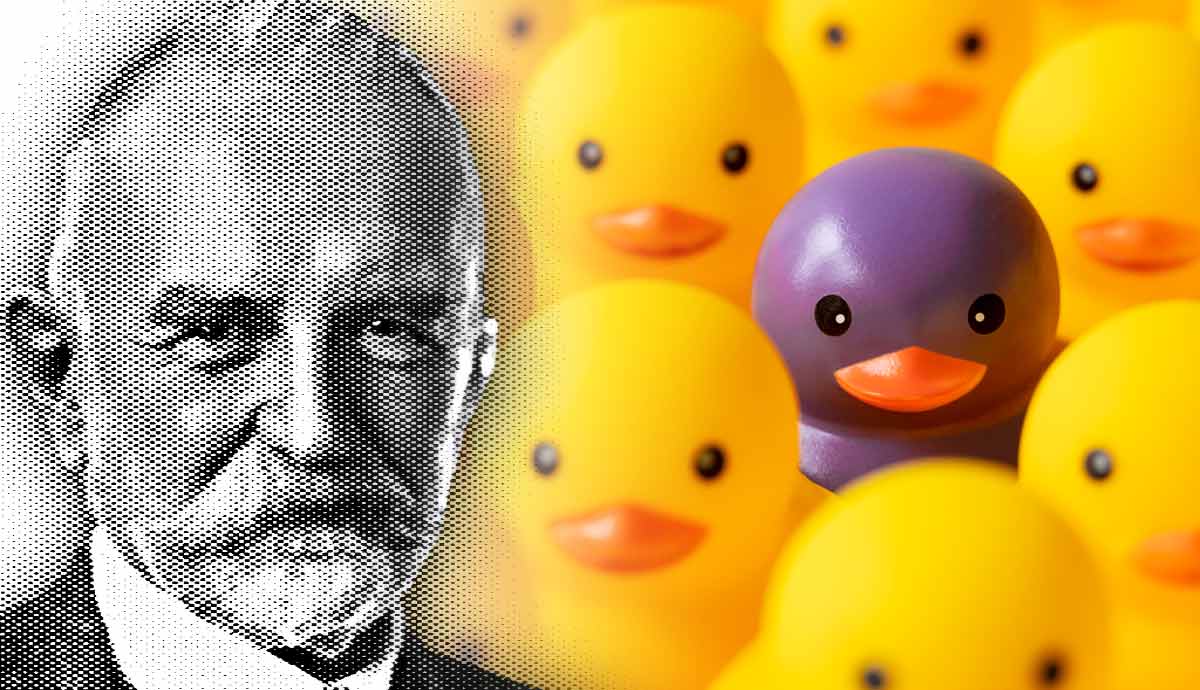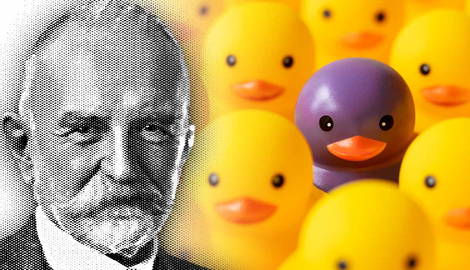
George Herbert Mead was a sociologist who devoted a great body of work toward a theory of the Self. He was especially concerned with the relationship between Self and Others, especially with the question, “How can we understand others?” In his view, our Self is born within our relationship with other people, and it wouldn’t exist if we were alone. This leads to a completely new theory for the birth and evolution of the Self, which we’ll explore in this article.
Herbert Mead’s New Perspective on the Self

When we think about the Self, we usually think about something already within the individual when they are born that develops throughout their lifetime. This classic view of the Self is the one that dominated Western thought almost throughout the history of philosophy, and even early psychology was heavily influenced by this.
Let’s take, for example, Sigmund Freud’s work. His research assumes that such a thing as the Self exists from the moment we are born, and the exterior world and our interior world later shape it.
This take on the Self-created a long-lasting problem for philosophy, and that’s the problem of intersubjectivity. How can we understand the others? What makes one Self able to communicate with another Self?
Through time, many philosophers, psychologists, and scientists tackled this topic. George Herbert Mead’s contribution is very interesting because it simply doesn’t share the assumption that created the problem in the first place.
In Mead’s view, the Self cannot exist outside of society. Our Self is born because of our communication with others, and it couldn’t exist before that. According to Mead, the Self is a social process, and so is our mind.
There is no need to ask: “How can we understand others?” simply because our ability to understand others makes the Self possible. This leads to a completely new definition of what the Self is and how it works.
The Self: Between the “I” and the “Me”

Mead’s version of the Self is made of two components. The first is the “Me.” This is what the individual learns through social interactions; it represents what they know others, especially significant others, will expect from them. The “Me” represents the individual’s social role in their social context; it introduces every social law and norm, and it’s the first brick of the Self.
The individual will behave and act according to what they have been taught; he will try to fulfill his social role, which will be the cornerstone of their Self.
Of course, the “Me” wouldn’t be enough to explain the Self. If that were the case, people would be automatons, blindly following the rules and norms society imposed on them. (Which, in turn, would create another problem: how could social norms come to be in a society composed of automatons that can only follow the rules, but not create them?)
The individual has a creative response to social norms, the “I.” The “I” is born after the “Me,” and it’s the individual’s answer to external expectations. The “I” makes every individual unique because there’s no way to know how it will be shaped; it reflects the individual’s “true” personality, their uniqueness.
The Importance of Play and Games

According to Mead, one key concept to understanding the development of the Self is play. In Mead’s view, playing is extremely important because it allows the children to understand a “role” in the first place and, more importantly, what their role in society is and what other people expect from them.
Today, we know play is crucial to developing our social abilities because it allows us to experiment, understand what rules are, and know how to respect or break them. You could read Gregory Bateson’s work on the subject to grasp the importance of play better.
For Mead, playing has two forms: play and game. The child first learns to play, and Mead essentially sees it as role-play. The child plays the social roles of adults: he pretends to be a doctor, a policeman, a thief, and so on. This allows the child to better grasp social roles: they start to understand how a person must behave in a certain role and what should and shouldn’t be done in that role.
The key aspect is that the child in this phase can only take the role of specific people: they learn how to behave towards others, but their understanding of the social process is limited to specific situations.
And that’s where the game stage comes in. The game is different from play because it’s far more complex. A clear example is a sports game. There are many rules to be followed, and you need to remember not only your role but also everyone else’s role and how these roles combine.
For example, let’s say you’re playing as an attacker on a football team. You need to know the rules of the game, of course, and your role in the team. After that, you also need to know what every other member of your team’s role is. Finally, you must also know the same about the other team’s players. Otherwise, you won’t be able to compete with them.
That’s what makes the game so important: it represents society as a whole. This is where the children learn how to be in a social group. One highlight from this is how crucial rules are to the Self’s development: through rules and roles, children can grasp what living with other people should be like.
This doesn’t mean that rules are eternal. Rules can be changed; sometimes, they should be broken because they can be unfair. After all, they’re human creations, and as such, they will have flaws. What’s important here is understanding the rules and how they allow the game to occur.
The Generalized Other

Through the game, the child introduces the expectations of the whole team. When they’re playing, though, they’re not thinking about every single member of the team separately; rather, they’re thinking about their team as a whole. And this is the children’s first encounter with the generalized other.
According to Mead, the generalized other allows us to live in a society. It represents the expectations of other people, whether we’re talking about a specific situation (like a sports game) or our life as a whole (our family members, our fellow citizens, etc.). We are always thinking about how other people will perceive what we think or what we do; that part of us is our generalized other.
As you may have guessed, this concept strongly resembles Freud’s Superego. However, there are a few key differences. The Superego acts like an internal judge, preventing some unconscious content from becoming conscious; the generalized other acts more like an instructor. It teaches us what we should do; it’s not as punitive as the Superego, and it’s much more focused on making us understand others, while the Superego is mainly concerned with acceptance.
Socialization and the Development of the Self

We all know that the external world plays a huge part in shaping our Self. Even in more conservative views, there’s no denying that the Self is heavily influenced by our surroundings, especially by other people. Let’s go back to Freud’s work once again. In his research, this is represented by the Superego, made from social norms and rules. The Superego acts like an internal judge of the Ego, and it decides which consent can be conscious and what must remain unconscious because it wouldn’t be acceptable for the society the individual lives in.
Mead takes this a step further: not only does the external world shape our Self, it creates our Self. Our self is born as a response to our social relationships; it couldn’t exist without them because there wouldn’t be a “Me” if there were no one to tell us what our place is in our social context.
It’s a fundamentally different take on the matter compared to what most philosophers and psychologists thought at the time, and it solves some old problems while creating new ones simultaneously. On the one hand, it’s indeed easier to explain how we can understand others, even if there’s still a need for a deeper explanation (which Mead does offer in other writings, albeit with unsatisfactory results). On the other hand, this theory makes it much more difficult to explain how society was born. How did social norms come to be? How could individuals group when there still weren’t established roles to play?
These questions aren’t answered here, but it would be interesting to try to answer them while remaining in a similar theoretical frame. Mead’s contribution to the theory of the Self can be considered much more interesting nowadays because recent scientific discoveries, such as mirror neurons, could be a key to understanding how important social relationships are in shaping our Self.










